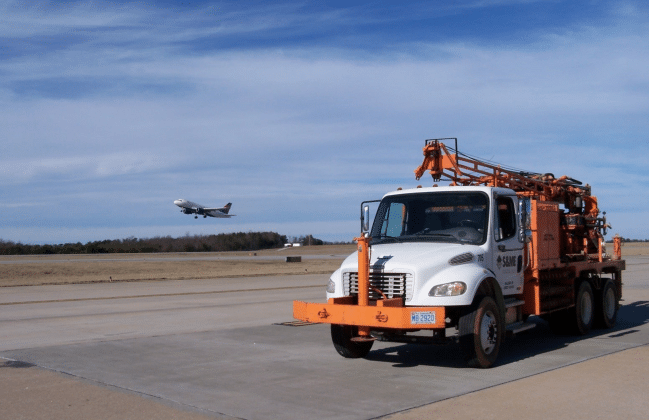Greenville-Spartanburg International (GSP) Airport – Taxiway G Pavement Repairs
S&ME was contracted to forensically explore and evaluate the possible causes of premature pavement failure within an approximately 250-foot long section of Taxiway G. This taxi lane connects GSP’s Runway 4-22 to the parallel Main Taxiway, and is approximately 74 feet wide by 800 feet long. The area of primary concern was the section of Taxiway G extending approximately 250 feet northeast from the hold bar. During rehabilitation in 2009, the asphaltic pavement milled, crack in the exposed milled surface were sealed, and an overlay was placed. Indications of pavement distress first appeared in late 2011, and continued to worsen over time, and included significant cracking, rutting and deflection. Much of the spread cracking was oriented at an angle (rather than longitudinal or transverse), and this cracking pattern suggested the pavement was likely sliding and pushing/shoving.
The field exploration included visual evaluation of the pavement surface failure modes and coring the asphaltic pavements at six locations. We measured the core thicknesses and observed the specimens for distress modes. We then performed soil test borings with SPT sampling and testing at three core locations. The cores were subjected to density, asphalt cement content, and gradation testing and the soil samples were subjected to Proctor, CBR, and index testing in our laboratory.
Based on our assessment of the cores specimens, we concluded the primary cause of the pavement distress was the presence of a cold joint (smooth plane with no tack coat) between upper/shallow pavement layers, and pavement materials of variable quality. The sloping cold joint apparently contributed to the pushing/shoving of the pavement when subjected to lateral shear loads of braking wheels. Our recommendations included milling the surface pavements to below the cold joint, crack sealing and overlay.
During the pavement repair, S&ME provided Quality Assurance testing at the asphalt paving supplier’s laboratory. Our personnel observed and documented testing of the hot mix asphalt (P-401), and bulk specific gravity testing of extracted mat/joint cores sampled following installation of the test strip and production paving. Our personnel helped troubleshoot when the paving contractor had difficulty obtaining specified compaction along lane joints.

